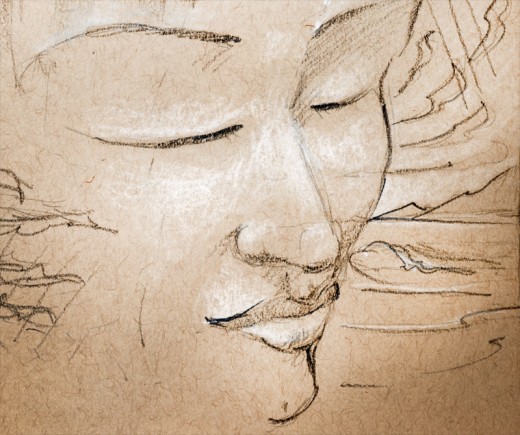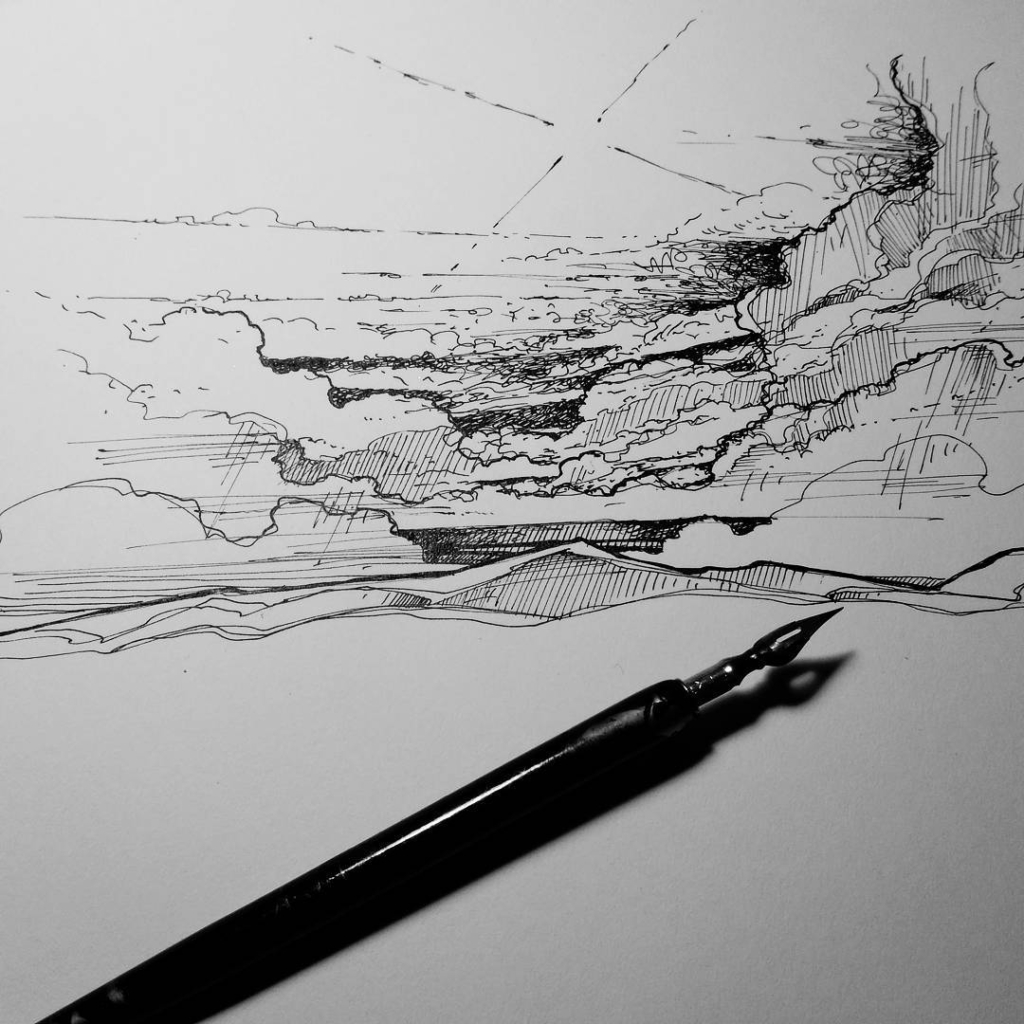How to be a Painter IV

or... "What works and what doesn't"
In art as in life, there is no right and wrong, good and bad, etc. There is only what works and what doesn't. Just as in life, there is that which is incongruous to our spirits and that which is beneficial to a compositionally balanced life. Daily yoga works quite well. Daily drunkenness doesn't work very well at all. So we choose what works within the rhythm of life to the degree that it creates something balanced and harmonically correct. When we choose to engage Life in that act of co-creation we are asking it to allow us to to participate in that compositional choice.
Happy Accidents

I assembled the stretcher bars to the desired size (18 x 14) and cut an appropriately sized rectangle of canvas. With pliers and staple gun I stretched it around the bars and then proceeded to gesso it. Once it appeared to be dry, I brushed on a background wash of yellow orange azo, burnt sienna, and a dash of dioxanine purple. But there was a several square inch spot in the middle of the bottom right corner that wasn't completely dry and so the wash picked up the gesso. This wasn't terrible in and of itself but it left a slight ridge between the original primed canvas and the freshly gessoed areas. I let it all dry and then went back and added more gesso to that area - creating a rather white sort of starburst on the yellow sienna background. After the gesso was dry I went back and washed over it with the original wash colors. Unfortunately this left sort of a lighter area under the final wash.
So turned the canvas upside down and suddenly it had the appearance of the sun setting behind a cloud bank. Magic. Perfect. And in just the right place....
Intentional Ambiguity Is Better Than Indecisive Vagueness

This is something I was thinking about while painting tonight. Often I leave things in my paintings rather ambiguous. Shapes are suggestive of animals or plants or clouds or structures. They are all inspired by countless things I see through the course of my days - the curve of the leaf of the plant in my garden or the arch of a cathedral I might happen upon. All of these things become part of the visual language and an artist can draw upon these shapes - even just the step of an edge or the clip of a curve - and use them to inform the work.
Now, the more you know - the more shapes and curves and lines and movements that you store in that visual memory - the more you can take your sense of 'I don't know what this is going to be' and simply shape it and allow it to take form and be informed by your visual memory and the feelings evoked by the different shapes you run across. Granted, it takes some practice to allow for the space to allow that through but with effort and practice (a sketchbook helps) you might find that this comes more easily than you realized.
Advice to Artists

Ideas about art and business and creativity for young artists and old ones too but it's the young ones who ask...
- If someone wants to buy your art only hand it over when it has been paid in full
- Contracts are good. Get everything in writing when making a deal.
- For any commissioned work, always get at least half up front.
- It's ok to do things for free but don't give yourself away all the time. Your time is valuable.
- 'Exposure' is good but so is eating and paying the bills.
- Don't be afraid to say no when it comes to selling your art for less than you want for it.
- Trust yourself and know when to walk away.
- Selling art feels like you are being supported but just because you haven't sold anything lately doesn't mean you aren't any good.
- Even the most successful artists suffer from self-doubt. Just do your best.
- Your friends are usually terrible critics.
- Your partner should be your second biggest fan (second to YOU).
- You are good enough but you can always get better.
- Beware of tropes.
- Your best work will always be done when you're sober.
- Straight lines are best made with a ruler.
- A string, a tack or piece of tape, and a pencil will give you a perfect circle.
- If you see something in your painting that you want to change - change it. Otherwise, it will nag at you every time you look at the painting.
- Sit and draw people in real life. Don't just draw the pretty ones.
- If you wear headphones when you paint, invest in a good pair.
- Look for natural spectrum light studio lights - they will give you the best light.
- Make sure your studio has plenty of sunlight. Caves can be depressing to work in.
- A great painting takes time. Don't be afraid of taking the time.
- Love what you do and what you make.
- Practice makes perfect.
The Rule of Thirds and Composition

I'd like to talk about composition.
The Rule of Thirds is, I think, the best way to consider a composition. Using this little painting for an example - take a look at where the lines intersect the painting. It almost falls perfectly into it's respective sections. The right edge of the left third intersects the cloud opening and also the center of one archway. The left edge of the right third cuts through the column - balancing out the openings on the left. In the smaller thirds even, the small person falls in the middle third of the bottom right corner thirds. The lowest line of clouds, too, starts at the top of the bottom third of the painting and slowly drifts upwards. Between these and other details, the painting ends up falling into a nice order and feeling like a really balanced composition and ends up being more engaging and pleasing to the eye.
The Work Triad for Artists

In my "career" as an artist (in quotes because when I was 20 it didn't seem so much a "career" as simply a need - a drive - a thing I was compelled to do) I've found that there's three main components of my work life:
- Work For Hire
- Work for Me
- Work for Free
We can never do any one of them all the time and remain happy and inspired. Instead we constantly cycle through them all. The quantity of time that we spend within each sphere is up to our own personal taste and need - some people find more satisfaction to weigh the scale heavier towards 'Work for Hire' while others towards the 'Work for Me.' And at times, the 'Work for Free' seems to take up TOO much time. However, all of them have their value and it is worth understanding how they support us.
Fonts (or HOW to say what you WANT to say)

Let's talk about fonts because HOW you say something is nearly as important as WHAT you are saying. Rhetoric - speaking and writing in a persuasive manner - goes far beyond simple word choice. Our choice of fonts in the branding of our message offers subtle clues to observers of how we think of ourselves, the kind of image we are want to portray, and the audience we hope to connect with. When we read a text, we are reading it in the tone the speaker wrote as much as the tone it is packaged in.
When choosing a font, some ideas to consider:
The Big Mistake or Keep Moving Forwards

It goes like this: You have made or saved or borrowed a nice chunk of money and have decided to invest in yourself. After all, people have told you to invest in things you believe in and YOU believe in YOU!
In any case, people have been telling you they would love to see your art on _______. Those several or a dozen resounding voices start to sound like a whole lot of resounding voices. Everyone you've told thinks it's a great idea. It's ambitious but so are you! You look into production. You visualize yourself calling up retailers and people handing you money for the _______ that you now offer. It will be an enormous success! Nagging doubts be damned!
Why You Should Make Art (according to science)

#5 - "Turning our problems into narratives can help us work through them" - is really a key part of my work. When I am thinking of what next to paint, I try to find works that help to guide me through my life, the preciously beautiful as well as the preciously tragic. The transference of thought into matter for no other reason than as an expression of ourselves and finding the patience to see it through, whether a napkin doodle or an epic painting, is an important part of our humanness to nurture.
And if it is only to make us happy and healthier humans - well, that's not so bad. After all, happier healthier humans make better choices for themselves and others. In my opinion, it makes for a better planet to live on.
The Value of F***ing Around

As an artist, they say, you should always be producing. And it should be better. And more. And also more better. And, the older you get, the more this adage echoes through your mind. Does what I'm doing have value? Is this worth the time I'm spending on it? How long until it's done and how will it compare to previous works? And so on. The questions, the inquiries, the pressures, the doubts - they're endless.
Looking back on the early days of my artistic career, I see a person who found value in creation for the sake of the thing. I just knew I wanted to make it. I had to. And I had nothing to compare it to. I had no previous sales. I had a small collection of work but not enough that I had a spectrum of pieces to compare anything to. There was no endless feed of social media to insert it into. I had only pen and paper, brush, canvas and paint, coupled with a will to simply create.